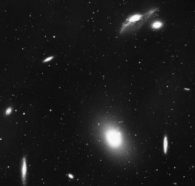Dark galaxy
Astronomers have spied a massive galaxy that appears to contain no stars.
By Emily Sohn
The Milky Way is packed with stars, comets, asteroids, moons, and planets, including our own. Other galaxies in the universe are similarly crammed full of stars and various objects.
Astronomers have now spied something very unusual. They’ve found a patch of space that looks empty but actually appears to be a galaxy that contains no stars. Theorists had proposed that such “dark” galaxies could exist, but no one had ever seen one before.
 |
|
The Virgo cluster contains more than 100 galaxies of various types. It’s the nearest large cluster to the Milky Way. Astronomers have now found evidence that it may also contain a mysterious “dark” galaxy that appears to have no stars.
|
| NOAO/AURA/NSF |
The mysterious object is in an area of space known as the Virgo cluster of galaxies. This cluster is the closet one to the Milky Way and contains more than 100 galaxies of various types, including spiral and elliptical galaxies. Five years ago, astronomers at Cardiff University in Wales noticed that this vast region has a pair of isolated clouds made up of hydrogen gas.
Further observations revealed that one of the clouds is associated with a faintly glowing galaxy. This makes sense because balls of hydrogen gas usually indicate an area where stars are forming.
The other hydrogen ball, however, appears to have no glowing galaxy as a partner. Yet, other observations suggest that it’s part of a massive object weighing as much as a galaxy of 100 billion suns.
 |
|
The mysterious, newly discovered “dark” galaxy is near this spiral galaxy, known as M99, which is also a member of the Virgo cluster of galaxies.
|
| NOAO/AURA/NSF |
The astronomers propose that the object, named VIRGOHI21, is full of a mysterious substance called dark matter. And they say there might be many more galaxies just like it. Astronomers just haven’t spotted them yet.
For now, there’s a lot of explaining to do.
“Seeing a dark galaxy—a galaxy without any stars—is like seeing a city without any people,” says astronomer Robert Minchin of Cardiff University. “We want to know why nobody lives there.”







